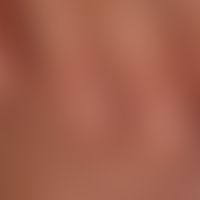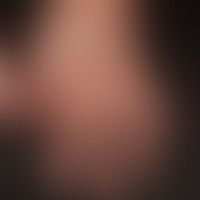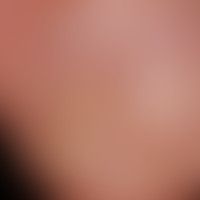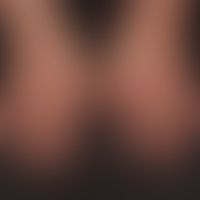
Mixed connective tissue disease M35.10
Mixed connective tissue disease. hyperkeratoticnail folds with elongated capillaries and focal haemorrhages. Note the splatter-like scars on the back of the fingers as well as the expression of focal, now healed scarred, cutaneous vascular occlusions.

Dermatomyositis (overview) M33.-
dermatomyositis: reflected light microscopy. hyperkeratotic nail folds. pathologically enlarged and torqued capillaries. older bleeding into the nail fold.

Acrocyanosis I73.81; R23.0;
Acrocyanosis in age-atrophied, shiny skin, alternating temperature-dependent colouring from medium red to deep red.

Adult dermatomyositis M33.1
Dermatomyositis. 72 year old patient with dermatomyositis known for 1 year. striped red, scaly papules and plaques over the base of the fingers. deep red, painful and slightly scaly plaques on the end phalanges, also directly periungual. distinct hyperkeratotic nail folds.

Dermatomyositis (overview) M33.-
Dermatomyositis: Flat red plaques on the end phalanges. Hyperkeratotic nail folds

Mixed connective tissue disease M35.10
Mixed connective tissue disease: stripy livid erythema on the back of the hand and the back of the fingers, collagenosis hand.

Chilblain lupus L93.2
Chilblain lupus. early stage with livid-red, smooth, painful plaques. clinical picture reminiscent of chilblain (frostbite lupus). acrocyanosis still moderately pronounced.

Dermatomyositis paraneoplastic M33.1

Glomus tumor D18.01
Glomus tumor. solitary, painful defect formation of the nail, accompanied by stabbing pain that occasionally radiated into the upper arm.

Hand-foot-mouth disease B08.4
Hand-Foot-Mouth Disease: since about 1 week, painful, blisters, pustules and papules on hands and feet; about 2 weeks before, unspecific flu-like prodromas.

Cryoglobulins and skin D89.1
Cryoglobulinemia: distinct, slightly painful acrocyanosis with little exposure to cold.

Mixed connective tissue disease M35.10
mixed connective tissue disease: 53-year-old female patient. known for several years raynaud syndrome. episodes have become more frequent in recent months. for about 3 months, increasing fatigue, lack of drive and strength, joint pain intensified in the morning, swelling of the hands and fingers (sausage fingers). ANA: 1.1280; U1RNP antibodies+.

Dermatomyositis (overview) M33.-
Dermatomyositis (overview): Striped arrangement of red papules and plaques, which confluent to flat areas in the area of the end phalanges; strongly pronounced nail fold capillaries.

Dermatomyositis (overview) M33.-
Dermatomyositis: Flat red plaques on the end phalanges. Hyperkeratotic nail folds

Adult dermatomyositis M33.1
dermatomyositis: reflected light microscopy. hyperkeratotic nail folds. pathologically increased and enlarged torqued capillaries. older bleeding into the nail fold.

Adult dermatomyositis M33.1
Dermatomyositis. Gottron papules in a 72-year-old woman. Smaller, striated, reddish-livid papules appear, which confluent in the region of the end phalanges to form flat plaques. Strongly pronounced nail fold capillaries on dig. III and V. The Keining sign was strongly positive in the clinical examination.




